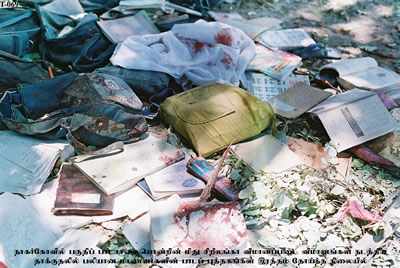.jpg)
Jaffna has been considered the cultural capital of Eelam Tamils for centuries, as well as being the crucible of the Tamil liberation movement and the armed struggle against Sri Lankan state operation which began in the 1970s following non-violent political campaigns.
Following the 1983 'Black July' pogrom in Colombo, fighting began between Tamil militants and Sri Lankan troops within the Jaffna peninsula - first against the Sri Lankan military and in the late 80’s, the Indian Peace Keeping Force (IPKF).
When the Indian army withdrew in 1990, the LTTE assumed control of Jaffna, except for the Sri Lankan Army base complexes along the peninsula’s northern cap and its neck.
Following the second phase of the war (known as Eelam War 2), the LTTE entered into negotiations with the government of President Chandrika Kumaratunga. Those talks broke down in contentious circumstances. The government accused the LTTE of rebuffing its peace efforts. The LTTE said the government was insincere about the peace and was playing for time.
When the war resumed in July 1995, the Sri Lankan armed forces had rearmed and expanded, acquiring helicopter gunships, heavier artillery and armour, as well as re-deploying troops from the eastern province into the Jaffna peninsula ahead of a new
military project - codenamed 'Operation Riviresa'.
.jpg)
Sri Lankan troops in Jaffna, 1995.
The first Sri Lankan military assault on Jaffna, codenamed ‘Operation Leap Forward’ occurred on 9 July 1995. Amongst those involved in the offensive was Sarath Fonseka, who would go on to head the army during the massacres at Mullivaikkal in 2009.
On the first day of ‘Leap Forward’, 65 civilians were killed and 150 seriously injured, when St Peters Church and the neighbouring Murugamoorthy Hindu Temple in Navaly were bombed by the Sri Lanka Air Force (SLAF). These places of worship were filled with hundreds of people, after the SLAF dropped leaflets saying that they should seek shelter in places of worship to avoid being targeted.
.jpg)
A mother mourns her child in Navaly.
From late July, the Sri Lankan armed forces began a continuous artillery and air bombardment to soften up the Valikaamam region.
On 21 September 1995, as the Sri Lankan military prepared to launch an offensive to recapture the northern city of Jaffna, new emergency regulations were imposed, granting widespread censorship powers on all war-related reporting. All reports had to be run past a government-appointed Competent Authority for Censorship before publication. The very next day, a primary school in the city was bombed by the Sri Lankan Air Force, killing dozens of Tamil civilians. A Reuters report on the incident was only published after it had been “subjected to military censors, who deleted quotes from civilians on the reported deaths of twenty children”.

The remnants of scattered schoolbooks from the Nagarkovil massacre.
The all-out ground assault to recapture the Jaffna peninsula from the LTTE began on October 1. The first phase, ‘Operation Thunder,’ was intended to capture parts of Valikaamam region, to the north of Jaffna town.
After two weeks the Sri Lankan army succeeded, despite heavy casualties, in capturing key towns including Atchuveli, Avarankal and Puttur. With the SLA’s strategy to cut off Jaffna town becoming clear, the LTTE deployed forces to prevent army columns from advancing to the Navatkuli bridge which linked Valikaamam with Thenmaradchi to the east.
The assault on Jaffna town itself, codenamed ‘Operation Riviresa’ (Sun Ray), began on October 17. Heavy fighting raged at several locations.
On October 29 Sri Lankan forces overran LTTE defences in Neervely after a pitched battle. Only one major defence line, in Kopay North, now lay between them and a relatively easy progress towards the Navatkuli Bridge.
It was the Sri Lankan army's battlefield tactics which panicked residents of Jaffna the most.
A former IPKF commander Lt. Gen. Amarjit Singh Kalkut later said:
“[the SLA] followed a strategy of broad front; [it] is a very secure method, but you need large forces, which they have got; it is more time consuming, but they’re in no hurry; and thirdly it causes a lot of destruction.”
“You are actually steamrolling through the area. Step by step. Do a certain distance first, then clean up, and converge on the next one. Any building from which resistance comes or is likely, bring it down with air bombing or tank fire. You clean up. But then as you pass, you’re leaving rubble behind. So for that problem [the Sri Lankans] have resorted to censorship so that this doesn’t come out. … They have concentrated overwhelming force for a Broad Front and have made sure there is no adverse publicity. World opinion, the press, don’t know what is happening because it is all controlled.”
On the morning of October 30, LTTE Political Wing cadres stood on the streets and making public announcements, urging civilians to seek shelter on the other side of Navatkuli bridge in Thenmaradchi.
Virtually the entire population, over half a million people, massed in the centre of the town and started the long walk towards safety, taking only what they could carry.
